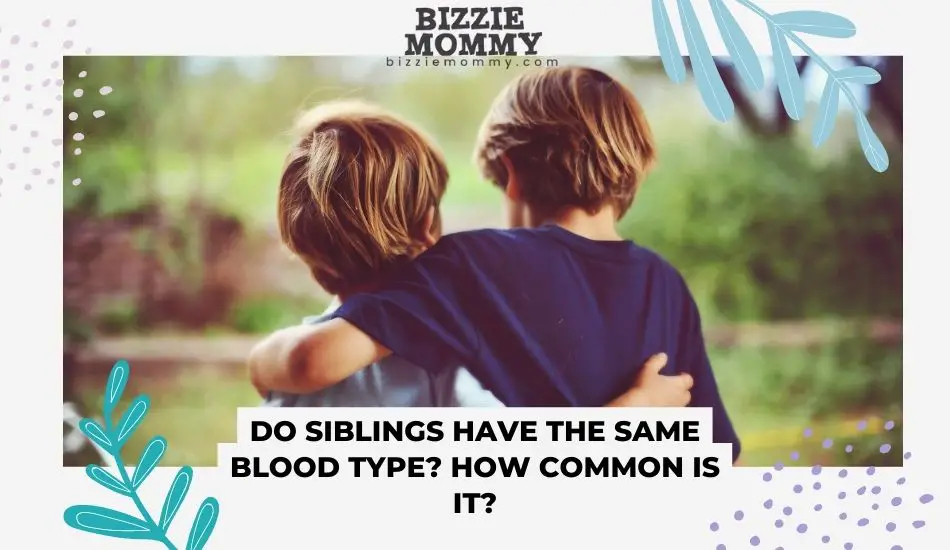Blood type is affected by many different factors. The biggest one is the parents’ blood type. But even so, there can be, and are, times when the child has different a blood type from that of his/her parents and even siblings. Genetics work in complicated ways, and that is what we will be discussing here:
It is not uncommon for siblings to have different blood types, even though they share 50% of their genetic makeup. The reason for this is that blood type is determined by multiple genes, not just one. While siblings inherit genes from their parents, they don’t necessarily inherit the same combination of genes. As a result, one sibling may inherit the genes for type A from one of the parents, while another sibling may inherit the genes for type B from the other parent. This means that siblings can have different blood types, even though they come from the same parents and share many genetic similarities. So, while siblings may look alike and share certain traits, their blood types can be different due to the complexity of genetics.
Do Babies Always Get Their Father’s Blood Type?
It is common for a child’s blood type to be the same as that of his/her parents, but there is no proof that the child inherits only the father’s blood type. Genetics works in wonderful ways, and kids get their traits from both the mother and the father.
There are four main blood groups, namely A, B, AB, and O. Whoever ends up with whichever blood group depends on whether their RBCs (red blood cells) have certain proteins. A simple explanation would be that those having blood group A have A-protein on their RBCs, those having the B group have B proteins, those having the AB group have both proteins, and those having the O group have none of the proteins on their RBCs.
When a child is conceived, he/she gets one copy of the gene responsible for the blood type from each parent. If the mother and father share the same blood type, the child’s blood type is also highly likely to be the same. In case the parents have different blood types, the child can either have one of the two blood types or even both, i.e., blood group AB.
However, there is also a possibility that the blood group of the child is completely different from the parents’. This is more common when both parents have different blood groups. If the child gets one gene from one parent (e.g., blood type A) and a different gene from the other parent (e.g., blood type B), the child could have blood group A, blood group B, blood group AB, or blood group O.
It’s important to note that blood type inheritance is not always straightforward, as there are multiple genes that can influence it. However, in general, it is not right to assume that babies always get their father’s blood type.
How Often Do Siblings Have The Same Blood Type
The only time siblings have 100% of the same genetic material is when they are identical twins. Siblings who are not identical twins share about 50% of their DNA, so there is a good chance that they will have the same blood type. This usually depends on the genetics carried by the parents, which get passed down to the children.
If the mother and father have the same blood type, the kid will almost certainly have it as well. If the parents have different blood types, the kid may have one of the two blood types or both.
If both parents are heterozygous (have two distinct alleles) for the ABO blood type gene, siblings will have a 25% chance of inheriting the same blood type. This is due to the fact that there are four possible allele combinations that might result in each kid having a distinct blood type.
However, if both parents carry the same blood group, their children will too. In this case, siblings will always carry the same blood group.
Is Sharing Blood Type With Your Siblings Common
It is not rare for siblings to share a blood type, but it is not a guarantee. The possibility of siblings having the same blood type is determined by their parents’ blood types and the particular mix of genes that each sibling carries.
Generally, while siblings having the same blood type is not unusual, it is also common not to, as blood type inheritance is regulated by many genes. Certain blood types are also more prevalent than others, which affects the chance of siblings sharing the same blood type.
It’s important to note that knowing your blood type and the blood types of your family members can be important for medical reasons. For example, in some cases, blood transfusions or organ transplants may require a close blood type match to reduce the risk of complications or rejection.
Does a Person Have to Have The Same Blood Type as His or Her Brothers and Sisters?
It is not necessary for siblings to share the same blood group. The genes received from parents ultimately decide the blood type, and each sibling might inherit a different set of genes. If both parents share the same blood type, their children will most likely have the same blood type as well; however, if the parents have different blood types, their kids might well have various blood types. If both parents are heterozygous (have two distinct alleles) for the ABO blood type gene, siblings have a 25% chance of having the same blood type.
Do Half Siblings Have The Same Blood Type
Half-siblings may or may not have the same blood type. When two siblings have the same birth mother but multiple biological fathers, their blood types could be different from each other because the genetic makeup of both fathers would be different. They can, however, have the same blood type if they inherit identical genes from their common mother. Half-siblings with the same biological father but separate biological moms might also have the same blood type. In such circumstances, the blood type of the siblings will be determined by their father’s blood type and the particular mix of genes acquired from their mothers.
It should be noted that understanding the blood types of half-siblings might be useful for medical reasons. A close blood type match may be necessary for blood transfusions or organ transplants to reduce the risk of problems or rejection. As a result, it is advised that all pertinent medical information, including blood type, be revealed to healthcare providers in order to guarantee the best possible medical care.
Does a Child Usually Have The Same Blood Type as One of Their Parents?

A child’s blood type is normally something inherited, but there are some other cases too. Whether or not certain antigens are present on the RBC surface is the final deciding factor of the blood type. The four major blood types are A, B, AB, and O. The blood type of a person is determined by the mix of genes inherited from their parents.
If both parents carry O blood types, their kid is likely to have type O blood as well. If one parent has group B blood while the other carries group A blood, their kid might have type A, B, AB, or O blood. Both parents could have the same blood group, but still, their kid may have a different blood type because of genetic differences.
Generally, while a child usually receives their blood type from their parents, that is not always the case. A person’s blood type is determined by the precise mix of genes acquired from each parent, and there can be variances even among siblings with the same parents. Knowing your blood type is useful for medical purposes such as blood transfusions and organ transplants.
Gene-Protein Relationship
Genes and proteins are two important components of our bodies. Genes are our bodies’ instruction guides, directing our cells on what to do and when to do it. Proteins, on the other hand, are the workers who carry out the orders. These are the basic building blocks of our cells and tissues and play an important part in many of our body’s processes.
The interaction between genes and proteins is complicated. The instructions for producing proteins are incorporated into genes, but the process is not easy. It entails multiple processes and needs the help of many more molecules.
Transcription marks the start of the production of a protein. The DNA information in a gene is transcribed into a molecule called messenger RNA during transcription (mRNA). This occurs in the cell nucleus, which contains the DNA. As mRNA is synthesized, it exits the nucleus into the cytoplasm of the cell. Translation is the next stage in the production of a protein. During translation, a ribosome “reads” the mRNA and assembles a specific protein according to the instructions in the mRNA.
The ribosome reads three “letters” at a time from the mRNA code, and each three-letter code (called a codon) corresponds to a distinct amino acid. Amino acids serve as the foundation of proteins, and 20 distinct types of amino acids may be combined in a variety of ways to produce various proteins. The ribosome adds amino acids to a developing chain as it reads the mRNA, which finally folds into a three-dimensional structure to make a protein. Once the protein is finished, it may go through other alterations, such as the introduction of sugar molecules or other chemical groups before it is ready to perform its job in the body.
Gene-Protein and Blood Types
The RH blood system is a classification system used to describe the presence or absence of a certain protein, called the Rh factor, on the surface of red blood cells.
The Rh factor is determined by a specific gene called the RhD gene, which codes for the production of the Rh protein. If a person gets two copies of the RhD gene, they will have the Rh protein on their red blood cells and are said to be Rh-positive. If they get one or two copies of a non-functional RhD gene, they will not have the Rh protein on their RBCs and are said to have Rh-negative blood.
The RH system is not the same as the ABO system, which is the most familiar blood system (and also the most commonly used). While the ABO system determines whether blood type is A, B, AB, or O, the Rh system determines whether a person is Rh-positive or Rh-negative. AB- is the rarest type, and the rarest blood is the RH null. This blood type does not have any Rh antigens at all and is known as golden blood.
Bottom Line
A baby’s blood type is affected by the parent’s blood type. There is a high chance that the baby will have the same blood type as his biological parents, but it is not a guarantee. Along with blood type, the RH value of blood can also be the same or different in babies.
Some kids may be born with some of the rarest blood types, like AB negative or golden blood type. Genetics are affected by a lot of factors, and understanding why certain characteristics and traits show in people and certain others don’t is also influenced by many details. Though generally speaking, A and B kids are quite common; however, the cause behind this is not well-understood.

